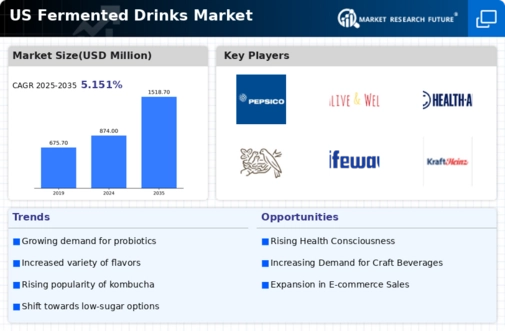Innovative Marketing Strategies
Innovative marketing strategies are playing a crucial role in the growth of the fermented drinks market. Brands are leveraging social media and influencer partnerships to reach a broader audience, particularly among younger consumers. Engaging content that highlights the health benefits and unique flavors of fermented beverages is resonating well with target demographics. Recent findings indicate that brands utilizing digital marketing have seen a sales increase of up to 25% compared to those relying on traditional advertising methods. This shift towards modern marketing techniques is likely to enhance brand loyalty and consumer engagement, ultimately driving sales in the fermented drinks market. As competition intensifies, companies will need to continuously adapt their marketing approaches to maintain relevance and attract new customers.
Expansion of Distribution Channels
The growth of the fermented drinks market is also being fueled by the expansion of distribution channels. Retailers are increasingly recognizing the potential of fermented beverages, leading to their inclusion in mainstream grocery stores and health food outlets. E-commerce platforms are also playing a pivotal role, providing consumers with convenient access to a variety of fermented drinks. Recent statistics show that online sales of fermented beverages have increased by over 30% in the past year. This shift in distribution strategy is likely to enhance market visibility and accessibility, allowing consumers to explore diverse options. As more brands enter the market, the competition will intensify, potentially leading to innovative product offerings and pricing strategies.
Rising Demand for Probiotic Beverages
The increasing awareness of health benefits associated with probiotics is driving demand for fermented drinks. Consumers are increasingly seeking beverages that promote gut health, immunity, and overall well-being. According to recent data, the probiotic drink segment is projected to grow at a CAGR of approximately 8% through 2026. This trend indicates a shift towards functional beverages, with consumers willing to pay a premium for products that offer health benefits. The fermented drinks market is likely to see a surge in probiotic-rich options, as brands innovate to meet this demand. Additionally, the rise of health-conscious consumers is influencing product formulations, leading to a broader range of options that cater to various dietary preferences, including vegan and gluten-free alternatives.
Sustainability and Eco-Friendly Practices
Sustainability is becoming a crucial factor in consumer purchasing decisions, significantly impacting the fermented drinks market. Brands that adopt eco-friendly practices, such as using organic ingredients and sustainable packaging, are likely to attract environmentally conscious consumers. Recent surveys indicate that approximately 70% of consumers prefer brands that demonstrate a commitment to sustainability. This trend is prompting manufacturers to rethink their supply chains and production methods, leading to innovations in fermentation processes that minimize waste and energy consumption. As the demand for sustainable products continues to rise, the fermented drinks market is expected to evolve, with more companies prioritizing environmental responsibility in their operations.
Cultural Influence and Traditional Fermentation
Cultural influences are significantly shaping the fermented drinks market, as traditional fermentation practices gain popularity. Many consumers are drawn to beverages that reflect cultural heritage, such as kombucha, kefir, and kvass. This trend is not only about taste but also about the storytelling behind these products. The resurgence of interest in artisanal and craft beverages is likely to drive growth in this segment. Data suggests that traditional fermented drinks are experiencing a revival, with sales increasing by approximately 15% annually. This cultural appreciation for fermentation is encouraging brands to explore authentic recipes and local ingredients, thereby enriching the diversity of offerings in the fermented drinks market.
























Leave a Comment